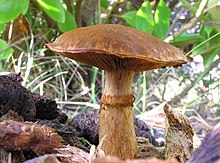Gymnopilus junonius
| Gymnopilus junonius | |
|---|---|
 |
|
| Scientific classification | |
| Kingdom: | Fungi |
| Division: | Basidiomycota |
| Class: | Agaricomycetes |
| Order: | Agaricales |
| Family: | Cortinariaceae |
| Genus: | Gymnopilus |
| Binomial name | |
|
Gymnopilus junonius (Fr.) P.D.Orton (1960) |
|
 |
|
| Approximate range of Gymnopilus junonius | |
| Synonyms | |
| Gymnopilus junonius | |
|---|---|
| Mycological characteristics | |
| gills on hymenium | |
| cap is convex | |
| hymenium is adnate | |
| stipe has a ring | |
| spore print is reddish-brown | |
| ecology is saprotrophic | |
|
|
edibility: psychoactive or inedible |
edibility: psychoactive
Gymnopilus junonius is a species of mushroom in the family Cortinariaceae. Commonly known as Laughing Gym, Laughing Cap, Laughing Jim, or the Spectacular Rustgill, this large orange mushroom is typically found growing on tree stumps, logs, or tree bases. Some subspecies of this mushroom contain the neurotoxic oligoisoprenoid gymnopilin.
This species was formerly known as Gymnopilus spectabilis, or Pholiota spectabilis v. junonia (Fr.) J.E Lange. The 'Gymn' in the present nomen means 'naked', and 'Juno' was the wife of Jupiter. In Korea, this mushroom is called Hwanggalsaek Michigwang-i Beoseot, which translates to "bronze clown mushroom".
The cap ranges from 7 to 20 cm across, is convex, and is bright yellow-orange in younger specimens and orange/brown or reddish brown in older ones, with a dry scaly surface. The stem is 2.5 to 26.5 cm long, 1 to 4 cm thick, and often narrows near the base. The frail ring is dusted with rusty orange spores, the flesh is yellow and the gill attachment to the stem is adnate to sub-decurrent. It has a bitter taste, stains red with KOH and turns green when cooked in a pan. The spore print is rusty orange. It occasionally bruises blue, especially smaller specimens or "runts". This mushroom usually grows in clusters from several to several dozen individuals, but sometimes grows solitary.
This mushroom is often mistaken for Gymnopilus ventricosus, which contains no psilocybin.
Gymnopilus junonius is a very widely distributed mushroom which grows in dense clusters under large or old trees, the most common being the silver maple. This mushroom grows just about everywhere that decaying wood can be found, but is most common in moist, lowland wooded areas near rivers.
...
Wikipedia
